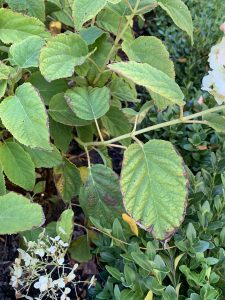
Hello. I am in Toronto, in a house. A month ago I had 16 incredibal hydrangea planted on my front gardens, which get partial shade. I have watered them carefully – although I was told not to overwater them. The soil is clay but we added 2 carts of triple mix. I also fertilized them once. Now the edges of the leaves are turning brown/black. I went to the garden centre, who told me it looks like they need more water. The gardener (who just cuts my lawn) said it’s normal fall behaviour at this time of the year. And my friend said it could be a fungus. What should I do?
When a plant’s leaves turn brown and crisp along the margin, it is usually a sign that it is dehydrated. Dried leaf edges are frequently observed on Hydrangeas as they are moisture-loving plants and don’t always get all the water they need. But since you have been watering diligently, it is more likely that yours are more stressed by their new surroundings and end-of-season weather changes, than by insufficient water.
On the other hand, when brown/black spots appear within the leaf itself, it can be a sign of fungal infection (leaf spot). Leaf spot damage is usually cosmetic and rarely fatal. You will know for sure that it is a fungal infection if the infected leaves drop prematurely. Since fungal spores overwinter in infected plant materials, remove the dead leaves promptly and dispose of them in the garbage, not in the compost or yard waste bin. The key is prevention, to try to break the cycle before it starts again next growing season. For more information, here is an article from the University of Florida Extension on hydrangea leaf spots late in the season.
Your plants are looking great, especially for this time of the year; I would focus more on preparing them for dormancy. Among the most important thing you can do is, you guessed it, proper watering! Water deeply and regularly, and don’t stop watering until the ground is frozen. During dormancy, the plant may be asleep but it is still alive and breathing and need moisture. If you are worried about overwatering (which can be a problem with clay soil) just check that the soil around your plants are not water-logged (water frozen around the roots will kill the plant as surely as lack of water will). Putting down a thick layer of mulch will help insulate and regulate the temperature of the soil and protect the roots.
We wish you the best of luck and many years of enjoyment with your hydrangeas.

